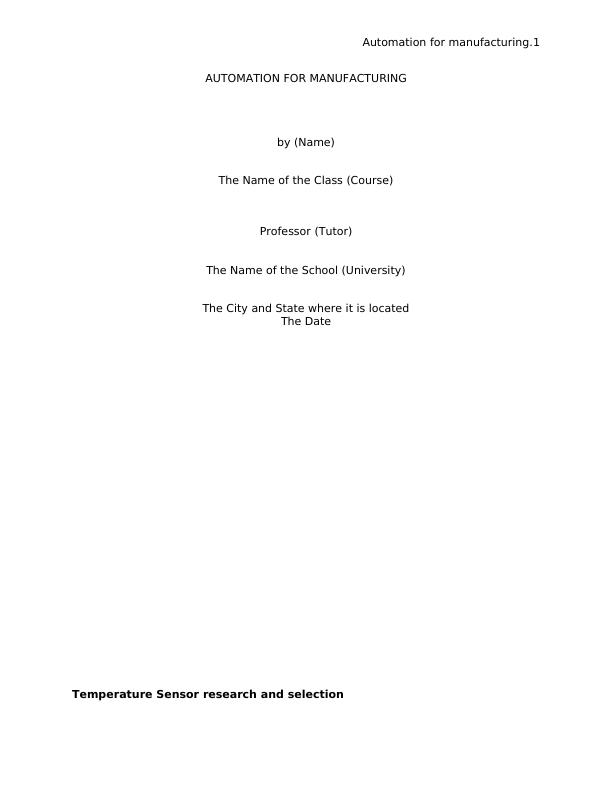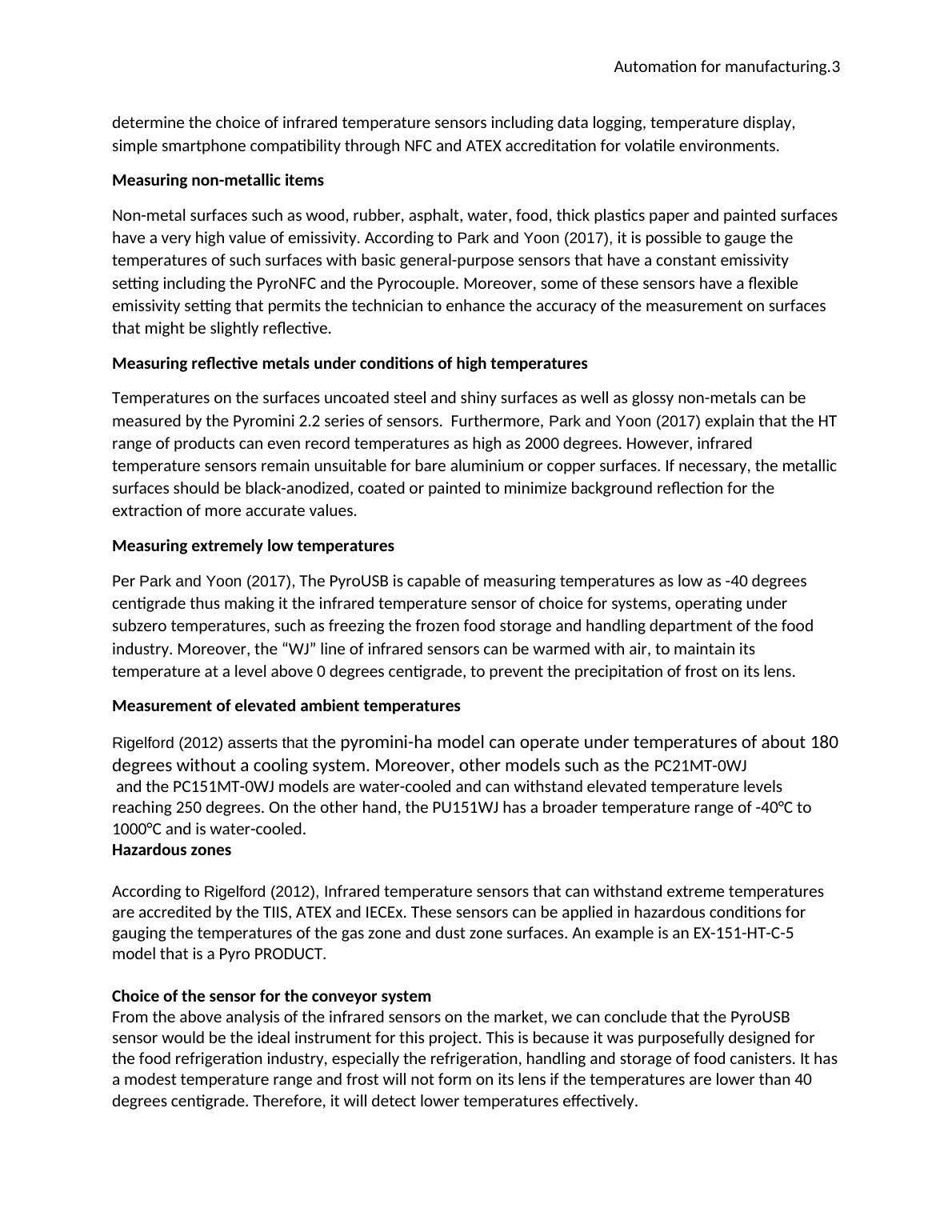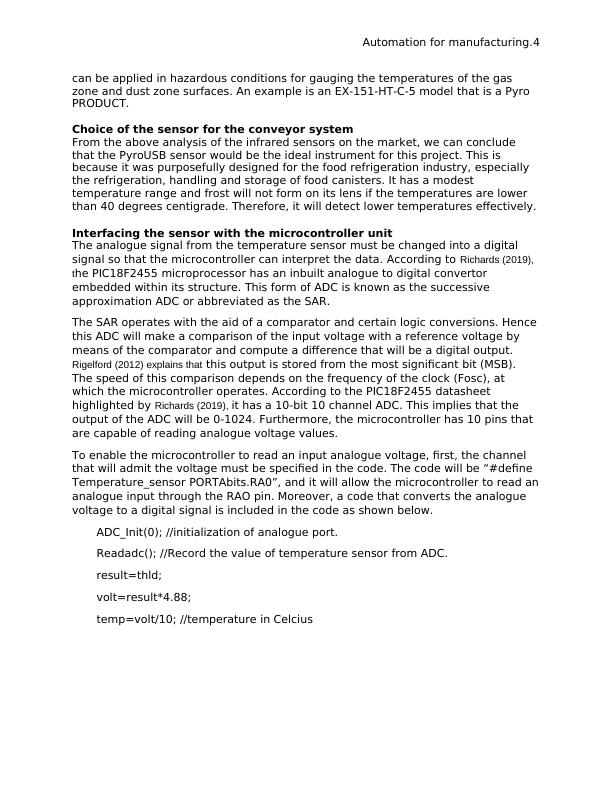Automation for Manufacturing Research 2022
Added on 2022-10-12
18 Pages5136 Words13 Views
Automation for manufacturing.1
AUTOMATION FOR MANUFACTURING
by (Name)
The Name of the Class (Course)
Professor (Tutor)
The Name of the School (University)
The City and State where it is located
The Date
Temperature Sensor research and selection
AUTOMATION FOR MANUFACTURING
by (Name)
The Name of the Class (Course)
Professor (Tutor)
The Name of the School (University)
The City and State where it is located
The Date
Temperature Sensor research and selection

Automation for manufacturing.2
It is essential to select the best temperature sensing device in the design of
temperature measurement circuits. After comprehending the specific needs of an
application, the best sensor that not is not only cost-effective but also upholds the
best standards of performance, reliability and accuracy, can be chosen for a project.
According to Buchannan (2013), sensors are generally divided into two categories.
These groups include the contact temperature sensors and the non-contact
temperature sensors. Furthermore, the contact sensors are divided into three key
groups including thermistors, resistance temperature devices and thermocouples.
Since our project involves the detection of temperature levels on objects in motion,
it is prudent that we focus on those sensors that do not have to be in physical
contact with the item, whose temperature is of interest.
Non-contact temperature sensors
Non-contact infrared temperature sensors are suitable for measuring the
temperatures of objects that are in motion, because they have a very fast response
time, in addition to equal or superior accuracy to the common contact temperature
sensing devices such as thermistors, thermocouples and resistance temperature
devices. Buchannan (2013) opines that before selecting the most desirable temperature
sensor there are several factors to consider including the temperature range, the
optical factors, the target material, the output, the ambient temperature and other
special features.
Myers (2014) asserts that it is important to consider the nature of the target material
because the general-purpose devices will generate more factual readings for non-
metallic materials, unlike reflective surfaces. On the other hand, short-wavelength
gadgets are designed to provide better results for bare steel and iron surfaces. In
terms of the temperature range, these sensors are categorized into models that can
measure either high, medium, low and wide temperature spans. Therefore, it is
important to determine the critical temperature of the particular system, before
specifying the temperature range and selecting the appropriate device.
Moreover, optics is an essential factor that determines the choice of a particular
instrument. The term optics describes the length of distance from the passing
object, and the geometry of the target object including its size. Moreover, Myers
(2014) argues that the position of the sensor in the arrangement of components is also
a crucial factor. Although researchers are still investigating the maximum distance
within which an infrared sensor remains effective, it is an established fact that the
measurement areas tend to increase with an increase in the span between the
sensor and the object. Conversely, the accuracy of measurement remains
unaffected by distance.
Furthermore, Myers (2014) explains that the ambient temperature of the target object is
a criterion that determines the choice of an appropriate instrument. Most infrared
temperature sensors can detect ambient temperatures that reach 60 to 70 degrees
centigrade. Moreover, other sensors with cooling systems or with the absence of
such technology can detect more elevated temperatures.
It is essential to select the best temperature sensing device in the design of
temperature measurement circuits. After comprehending the specific needs of an
application, the best sensor that not is not only cost-effective but also upholds the
best standards of performance, reliability and accuracy, can be chosen for a project.
According to Buchannan (2013), sensors are generally divided into two categories.
These groups include the contact temperature sensors and the non-contact
temperature sensors. Furthermore, the contact sensors are divided into three key
groups including thermistors, resistance temperature devices and thermocouples.
Since our project involves the detection of temperature levels on objects in motion,
it is prudent that we focus on those sensors that do not have to be in physical
contact with the item, whose temperature is of interest.
Non-contact temperature sensors
Non-contact infrared temperature sensors are suitable for measuring the
temperatures of objects that are in motion, because they have a very fast response
time, in addition to equal or superior accuracy to the common contact temperature
sensing devices such as thermistors, thermocouples and resistance temperature
devices. Buchannan (2013) opines that before selecting the most desirable temperature
sensor there are several factors to consider including the temperature range, the
optical factors, the target material, the output, the ambient temperature and other
special features.
Myers (2014) asserts that it is important to consider the nature of the target material
because the general-purpose devices will generate more factual readings for non-
metallic materials, unlike reflective surfaces. On the other hand, short-wavelength
gadgets are designed to provide better results for bare steel and iron surfaces. In
terms of the temperature range, these sensors are categorized into models that can
measure either high, medium, low and wide temperature spans. Therefore, it is
important to determine the critical temperature of the particular system, before
specifying the temperature range and selecting the appropriate device.
Moreover, optics is an essential factor that determines the choice of a particular
instrument. The term optics describes the length of distance from the passing
object, and the geometry of the target object including its size. Moreover, Myers
(2014) argues that the position of the sensor in the arrangement of components is also
a crucial factor. Although researchers are still investigating the maximum distance
within which an infrared sensor remains effective, it is an established fact that the
measurement areas tend to increase with an increase in the span between the
sensor and the object. Conversely, the accuracy of measurement remains
unaffected by distance.
Furthermore, Myers (2014) explains that the ambient temperature of the target object is
a criterion that determines the choice of an appropriate instrument. Most infrared
temperature sensors can detect ambient temperatures that reach 60 to 70 degrees
centigrade. Moreover, other sensors with cooling systems or with the absence of
such technology can detect more elevated temperatures.

Automation for manufacturing.3
Additionally, various infrared temperature sensors differ in terms of their outputs,
that are connected to microcontroller units. Therefore, there is a variety of sensors
that are built to be compatible with numerous outputs including USB, relay,
thermocouple, voltage and current. This facilitates the seamless connection of
sensors with other instrumentation components. Finally, other special accessories
determine the choice of infrared temperature sensors including data logging,
temperature display, simple smartphone compatibility through NFC and ATEX
accreditation for volatile environments.
Measuring non-metallic items
Non-metal surfaces such as wood, rubber, asphalt, water, food, thick plastics paper
and painted surfaces have a very high value of emissivity. According to Park and Yoon
(2017), it is possible to gauge the temperatures of such surfaces with basic general-
purpose sensors that have a constant emissivity setting including the PyroNFC and
the Pyrocouple. Moreover, some of these sensors have a flexible emissivity setting
that permits the technician to enhance the accuracy of the measurement on
surfaces that might be slightly reflective.
Measuring reflective metals under conditions of high temperatures
Temperatures on the surfaces uncoated steel and shiny surfaces as well as glossy
non-metals can be measured by the Pyromini 2.2 series of sensors. Furthermore,
Park and Yoon (2017) explain that the HT range of products can even record
temperatures as high as 2000 degrees. However, infrared temperature sensors
remain unsuitable for bare aluminium or copper surfaces. If necessary, the metallic
surfaces should be black-anodized, coated or painted to minimize background
reflection for the extraction of more accurate values.
Measuring extremely low temperatures
Per Park and Yoon (2017), The PyroUSB is capable of measuring temperatures as low as
-40 degrees centigrade thus making it the infrared temperature sensor of choice for
systems, operating under subzero temperatures, such as freezing the frozen food
storage and handling department of the food industry. Moreover, the “WJ” line of
infrared sensors can be warmed with air, to maintain its temperature at a level
above 0 degrees centigrade, to prevent the precipitation of frost on its lens.
Measurement of elevated ambient temperatures
Rigelford (2012) asserts that the pyromini-ha model can operate under temperatures
of about 180 degrees without a cooling system. Moreover, other models such
as the PC21MT-0WJ
and the PC151MT-0WJ models are water-cooled and can withstand elevated
temperature levels reaching 250 degrees. On the other hand, the PU151WJ has a
broader temperature range of -40°C to 1000°C and is water-cooled.
Hazardous zones
According to Rigelford (2012), Infrared temperature sensors that can withstand
extreme temperatures are accredited by the TIIS, ATEX and IECEx. These sensors
Additionally, various infrared temperature sensors differ in terms of their outputs,
that are connected to microcontroller units. Therefore, there is a variety of sensors
that are built to be compatible with numerous outputs including USB, relay,
thermocouple, voltage and current. This facilitates the seamless connection of
sensors with other instrumentation components. Finally, other special accessories
determine the choice of infrared temperature sensors including data logging,
temperature display, simple smartphone compatibility through NFC and ATEX
accreditation for volatile environments.
Measuring non-metallic items
Non-metal surfaces such as wood, rubber, asphalt, water, food, thick plastics paper
and painted surfaces have a very high value of emissivity. According to Park and Yoon
(2017), it is possible to gauge the temperatures of such surfaces with basic general-
purpose sensors that have a constant emissivity setting including the PyroNFC and
the Pyrocouple. Moreover, some of these sensors have a flexible emissivity setting
that permits the technician to enhance the accuracy of the measurement on
surfaces that might be slightly reflective.
Measuring reflective metals under conditions of high temperatures
Temperatures on the surfaces uncoated steel and shiny surfaces as well as glossy
non-metals can be measured by the Pyromini 2.2 series of sensors. Furthermore,
Park and Yoon (2017) explain that the HT range of products can even record
temperatures as high as 2000 degrees. However, infrared temperature sensors
remain unsuitable for bare aluminium or copper surfaces. If necessary, the metallic
surfaces should be black-anodized, coated or painted to minimize background
reflection for the extraction of more accurate values.
Measuring extremely low temperatures
Per Park and Yoon (2017), The PyroUSB is capable of measuring temperatures as low as
-40 degrees centigrade thus making it the infrared temperature sensor of choice for
systems, operating under subzero temperatures, such as freezing the frozen food
storage and handling department of the food industry. Moreover, the “WJ” line of
infrared sensors can be warmed with air, to maintain its temperature at a level
above 0 degrees centigrade, to prevent the precipitation of frost on its lens.
Measurement of elevated ambient temperatures
Rigelford (2012) asserts that the pyromini-ha model can operate under temperatures
of about 180 degrees without a cooling system. Moreover, other models such
as the PC21MT-0WJ
and the PC151MT-0WJ models are water-cooled and can withstand elevated
temperature levels reaching 250 degrees. On the other hand, the PU151WJ has a
broader temperature range of -40°C to 1000°C and is water-cooled.
Hazardous zones
According to Rigelford (2012), Infrared temperature sensors that can withstand
extreme temperatures are accredited by the TIIS, ATEX and IECEx. These sensors

Automation for manufacturing.4
can be applied in hazardous conditions for gauging the temperatures of the gas
zone and dust zone surfaces. An example is an EX-151-HT-C-5 model that is a Pyro
PRODUCT.
Choice of the sensor for the conveyor system
From the above analysis of the infrared sensors on the market, we can conclude
that the PyroUSB sensor would be the ideal instrument for this project. This is
because it was purposefully designed for the food refrigeration industry, especially
the refrigeration, handling and storage of food canisters. It has a modest
temperature range and frost will not form on its lens if the temperatures are lower
than 40 degrees centigrade. Therefore, it will detect lower temperatures effectively.
Interfacing the sensor with the microcontroller unit
The analogue signal from the temperature sensor must be changed into a digital
signal so that the microcontroller can interpret the data. According to Richards (2019),
the PIC18F2455 microprocessor has an inbuilt analogue to digital convertor
embedded within its structure. This form of ADC is known as the successive
approximation ADC or abbreviated as the SAR.
The SAR operates with the aid of a comparator and certain logic conversions. Hence
this ADC will make a comparison of the input voltage with a reference voltage by
means of the comparator and compute a difference that will be a digital output.
Rigelford (2012) explains that this output is stored from the most significant bit (MSB).
The speed of this comparison depends on the frequency of the clock (Fosc), at
which the microcontroller operates. According to the PIC18F2455 datasheet
highlighted by Richards (2019), it has a 10-bit 10 channel ADC. This implies that the
output of the ADC will be 0-1024. Furthermore, the microcontroller has 10 pins that
are capable of reading analogue voltage values.
To enable the microcontroller to read an input analogue voltage, first, the channel
that will admit the voltage must be specified in the code. The code will be “#define
Temperature_sensor PORTAbits.RA0”, and it will allow the microcontroller to read an
analogue input through the RAO pin. Moreover, a code that converts the analogue
voltage to a digital signal is included in the code as shown below.
ADC_Init(0); //initialization of analogue port.
Readadc(); //Record the value of temperature sensor from ADC.
result=thld;
volt=result*4.88;
temp=volt/10; //temperature in Celcius
can be applied in hazardous conditions for gauging the temperatures of the gas
zone and dust zone surfaces. An example is an EX-151-HT-C-5 model that is a Pyro
PRODUCT.
Choice of the sensor for the conveyor system
From the above analysis of the infrared sensors on the market, we can conclude
that the PyroUSB sensor would be the ideal instrument for this project. This is
because it was purposefully designed for the food refrigeration industry, especially
the refrigeration, handling and storage of food canisters. It has a modest
temperature range and frost will not form on its lens if the temperatures are lower
than 40 degrees centigrade. Therefore, it will detect lower temperatures effectively.
Interfacing the sensor with the microcontroller unit
The analogue signal from the temperature sensor must be changed into a digital
signal so that the microcontroller can interpret the data. According to Richards (2019),
the PIC18F2455 microprocessor has an inbuilt analogue to digital convertor
embedded within its structure. This form of ADC is known as the successive
approximation ADC or abbreviated as the SAR.
The SAR operates with the aid of a comparator and certain logic conversions. Hence
this ADC will make a comparison of the input voltage with a reference voltage by
means of the comparator and compute a difference that will be a digital output.
Rigelford (2012) explains that this output is stored from the most significant bit (MSB).
The speed of this comparison depends on the frequency of the clock (Fosc), at
which the microcontroller operates. According to the PIC18F2455 datasheet
highlighted by Richards (2019), it has a 10-bit 10 channel ADC. This implies that the
output of the ADC will be 0-1024. Furthermore, the microcontroller has 10 pins that
are capable of reading analogue voltage values.
To enable the microcontroller to read an input analogue voltage, first, the channel
that will admit the voltage must be specified in the code. The code will be “#define
Temperature_sensor PORTAbits.RA0”, and it will allow the microcontroller to read an
analogue input through the RAO pin. Moreover, a code that converts the analogue
voltage to a digital signal is included in the code as shown below.
ADC_Init(0); //initialization of analogue port.
Readadc(); //Record the value of temperature sensor from ADC.
result=thld;
volt=result*4.88;
temp=volt/10; //temperature in Celcius

End of preview
Want to access all the pages? Upload your documents or become a member.
Related Documents
Automation for Manufacturing: Non-Contact Temperature Sensors and PIC Microcontroller Programminglg...
|24
|5927
|387
Automation for Manufacturing: Comparison of Temperature Sensors and Infrared Temperature Sensorlg...
|14
|5102
|185
Organizational Structures and Design - Assignmentlg...
|16
|2518
|166
